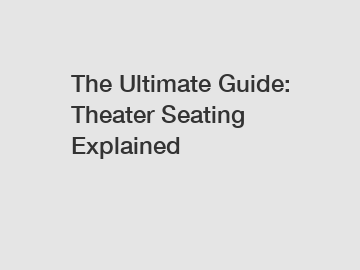The Ultimate Guide: Theater Seating Explained
The Ultimate Guide: Theater Seating Explained.
When it comes to enjoying a movie or a live performance, theater seating plays a crucial role in providing comfort and enhancing the overall experience. Understanding the different types of theater seating and their features can help you make an informed decision while purchasing tickets for your favorite show. In this guide, we will delve into the various aspects of theater seating, providing insights into the types, configurations, and optimal seating arrangements.
Different Types of Theater Seating.

1. Traditional Theater Seating.
Traditional theater seating refers to the classic, fixed-seat arrangement commonly found in theaters. These seats are typically arranged in rows facing the stage or screen, ensuring an unobstructed view for all guests. The chairs are often cushioned and upholstered, providing a comfortable experience for the audience.
2. Stadium Seating.
Stadium seating, also known as tiered seating, is increasingly popular in modern theaters. Here, the seats are arranged in elevated rows that resemble a stadium. This design allows every viewer to have an unobstructed line of sight, regardless of the seating position. With stadium seating, you can effortlessly enjoy a clear view of the stage or screen without any distractions.
3. Recliner Seats.
For those who prefer extra comfort, recliner seats are an excellent option. These seats come with adjustable backrests and footrests, allowing you to find your desired position for ultimate relaxation. Recliner seats are often available in a limited number to maintain optimum seating capacity while providing a luxurious experience.
Optimal Seating Arrangements.
1. Prime Seating.
Prime seating refers to the best seats in the theater, offering the most optimal view and sound experience. These seats are typically located in the center of the theater, equidistant from the stage or screen. They provide an immersive experience, with the sound and visuals perfectly aligned. If you want to enjoy the performance to the fullest, prime seating is the way to go.
2. Balcony Seats.
Balcony seats are usually located on the upper levels of the theater. While they may offer a more distant view, they often provide unique perspectives, especially for larger venues. Balcony seats can be an excellent choice if you prefer a wider view or a different angle to appreciate the entire performance.
3. Aisle Seats.
Aisle seats are preferred by individuals who value accessibility and convenience. These seats are located near the aisles, allowing easy entry and exit without interrupting the rest of the audience. Additionally, they provide extra legroom and are suitable for individuals who may require frequent movement.
Conclusion.
Understanding the different types of theater seating and optimal seating arrangements can greatly enhance your theater experience. Whether you prefer the traditional fixed seat arrangement, the elevated rows of stadium seating, or the luxurious comfort of recliner seats, knowing what works best for you is essential. Additionally, choosing between prime seating, balcony seats, or aisle seats depends on your preferences and the type of performance.
For any further inquiries or assistance with theater seating, feel free to contact us. Our knowledgeable team is always here to help you make the most out of your theater experience.
[Closing paragraph].
In conclusion, theater seating is a key aspect of enjoying a movie or live performance. By understanding the different types of theater seating and optimal seating arrangements, you can select the perfect seat to maximize your viewing pleasure. Remember to prioritize comfort and accessibility when choosing your seat. For any additional questions or assistance with theater seating, please do not hesitate to contact us.
If you want to learn more, please visit our website 3 seater waiting blue, 3 seater metal chair price, wholesale 4 seater chair for hospital.

Comments
0